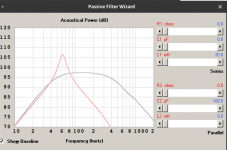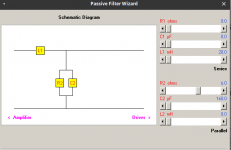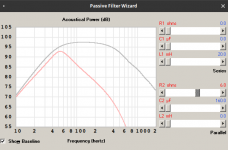If hornresp is correct the really low crossover points needed for a 2.5 way system should lead to a pretty nasty resonant peak. I think I may have stumbled on a way to tame that. Here is a rather extreme example.

The suggested technique is a resistor in parallel with the capacitor (2nd order filter). By adjusting the value of the resistor you can get the lower part of the response curve to line up with the original pretty well at least in the simulation.


Is my barking centered around the wrong part of the forest?
The suggested technique is a resistor in parallel with the capacitor (2nd order filter). By adjusting the value of the resistor you can get the lower part of the response curve to line up with the original pretty well at least in the simulation.
Is my barking centered around the wrong part of the forest?
Attachments
Hi Mashaffer,
Me think that a resistor that is in parallel with the driver will drive the efficiency lower and the resister must handle lot of power and huge.
Me think that a resistor that is in parallel with the driver will drive the efficiency lower and the resister must handle lot of power and huge.
The common solution is to remove the upper impedance peak (assuming its a vented enclosure). Connect a resistor, capacitor and coil in series and put that network in parallel to the bass driver. Search for 'RCL network' and 'impedance correction'.
Most 0.5 way roll offs I've seen have been 1st order slopes. Have I missed any articles on 2nd order versions ?
Thanks,
Rob.
Thanks,
Rob.
Hi mashaffer,
At frequencies near resonance the speaker's impedance will vary greatly. Have you included the speaker's impedance in your simulations?
Peter
At frequencies near resonance the speaker's impedance will vary greatly. Have you included the speaker's impedance in your simulations?
Peter
Hi mashaffer,
At frequencies near resonance the speaker's impedance will vary greatly. Have you included the speaker's impedance in your simulations?
Peter
The sim is done in hornresp which takes voice coil resistance and inductance as input parameters so I presume that he is using that info in these functions.
As long as the value of resistor does not get too low, this can be done with a 2tW or even 50W resistor. I would keep it above 40 ohms to not reduce driver sensitivity too much.
And of course, RLC is better.
Wolf
And of course, RLC is better.
Wolf
The sim is done in hornresp which takes voice coil resistance and inductance as input parameters so I presume that he is using that info in these functions.
Hornresp takes the total electrical input impedance of the loudspeaker into account, not just the effects of Re and Le.
Hornresp takes the total electrical input impedance of the loudspeaker into account, not just the effects of Re and Le.
Thank you David. Your hard work is very much appreciated.
2.5 way is usually used to offset baffle step, not to boost the lf response.
You can use it to extend the LF response downwards by rolling off your LP a bit earlier and take a slight hit in mid band efficiency, rather than fill up the lower mid bass with the .5 driver, as is done more commonly with a 2.5 way.
Many manufacturers want to build a slimmer speaker with multiple LF drivers to increase LF output capability, so instead of using the .5 to make up for baffle loss, its utilized to bump LF output capacity, which in most cases ends up being a bloated and muddy sounding speaker instead of achieving best mid bass linearity. This is something B&W tend to be guilty of as well as a few otherwise respected brands.
- Home
- Loudspeakers
- Multi-Way
- Dealing with res peak 2.5 way


